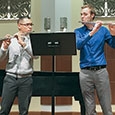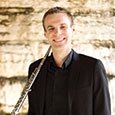Do you ever think back to the first time you picked up a flute? I have been playing the flute for over 15 years. That is more than 5,500 days since Day 1 when I opened the case with what I assume was wonder, excitement, and cluelessness as to what to do with the tube of metal. I have opened the flute case so many times that I have forgotten that first day. However, every fall, I teach new beginning students who are just starting their journey with the flute. As I think about all of the joys and struggles they will go through, I often wonder if there is something that teachers could learn from remembering back to their time as beginners that would help them teach more effectively.

photo by Valerie Simosko
Reliving Day 1
In February of 2017 my former teacher Mary Stolper and I were chatting about teaching beginners and how hard it can be to relate to their struggles because it has been so long since we started playing. Mary was telling me about a left-hand flute she has that is a mirror instrument of a normal flute. She said I had to try it as it would remind me about the experience of being a beginner again.
When she brought it to me, I opened the case and was shocked at how foreign it looked because it was backwards in the case. I froze and I did not know what to do with it. Being the wonderful teacher she is, Mary guided me as I fumbled to put it together. I felt a little silly and indeed like a beginner again. At the same time, I was filled with curiosity about this new instrument. How do I put it together? How do I hold it? What is it like to play? After figuring out how to hold it, awkwardly I might add, I packed it up to take home. Before leaving, Mary had one other bit of advice. “Make sure you practice over a soft space because you might drop it.”
My first practice session that night was for 10 minutes. Holding the instrument was beyond awkward, and I almost dropped it twice. So much for being a professional. I finally was able to hold an F, while my left-hand fingers were flying high (just like a beginner’s right-hand fingers). I could not focus on my fingers being close to the keys; it was hard enough balancing the flute just above my right-hand index finger knuckle. With many laughs and furrowed eyebrows, I slowly moved my fingers and managed an F major scale with a mistake on almost every note. Talk about being thrown into a student’s experience; I had forgotten how difficult it is to hold the flute properly.
I do my best to be a compassionate and understanding teacher, but it can be a challenge sometimes. I used to wonder, why don’t students balance it better with their right thumb? Why are their fingers so high? After that first session, I put the left-hand flute away for two months.
In March, I realized I needed to give it back to Mary in about a month. I am always looking for new and creative projects, so I pulled it out again and immediately started thinking about the possibilities.
A Month of Thinking Backwards
Thus began my Left-Hand Flute Project. For 30 days, I practiced 20 minutes a day, the average amount that a beginner would. My goal was to explore what it was like to be a beginner again and make a YouTube video about each day of practice. The videos are available on YouTube under my channel, Innovative Flutist.
It was an eye-opening experience. On day one, I could barely hold the flute. When I managed to honk out Hot Cross Buns, I got that same excited look students make when they play their first sound or play a song well for the first time. Over the first couple of weeks, I experienced the struggles that students go through holding the instrument and trying to remember the correct fingerings.
Middle C-D-E were the most frustrating notes on the left-hand flute for me. I already knew they were challenging on a normal flute, but I was deeply frustrated as I struggled to balance the flute properly and put the correct fingers down. Many days, I wanted to avoid them at all costs.
Balancing between the two hands and chin was also quite uncomfortable. I did not begin to feel comfortable with it until week three. Happily, I can say I didn’t drop the flute again!
Trying to remember to keep my first finger up for middle D and Eb was a joke. I wish I had a dime for every time I made that mistake in those 30 days. My empathy for beginning students was rapidly expanding each day I worked with this instrument.
By week three, I was playing scales and pieces from Louis Moyse’s 40 Little Pieces in Progressive Order. Nearing week four, I managed to learn how to play Telemann’s Sonata in F Major. While reflecting on the first three weeks, I realized that even with all of the struggles that I had with posture and fingerings, I still had a huge advantage over beginner students. I could already read music, produce a sound, breathe well, and count. I also understood the concepts of posture and fingerings and had 15 years of experience with the discipline and knowledge needed to effectively practice music. In reality, I was only learning two things: fingerings and how to hold the left-hand flute. Those proved challenging enough.
A New Perspective
I began to comprehend the flute experience from a beginner’s perspective. I realized what aspects they might be able to focus on and how easy it is to overwhelm them with too many things to think about. Being a beginner at flute or anything else for that matter is hard and takes courage. There are so many elements to think about simultaneously and improve on at the beginning. To avoid overwhelming new students, teachers should be thoughtful and selective about what they ask beginners to focus on. I have definitely overloaded my students with things to think about while playing. Over the 30 days, I became a more compassionate and thoughtful teacher. This has helped me to develop patience and an even more positive relationship with my students.
A Mirrored Performance
At the end of the 30 days, I presented this project at the Chicago Flute Club Membership Showcase. I shared the knowledge and experience I gained from learning the left-hand flute and performed two duets by Ernesto Kohler with Chicago flutist, Steve Yepez. It was an amusing experience having two flutes face the opposite direction. During the performance, I was mainly focused on playing the correct notes, which made me realize how much more nerve wracking it can be for a beginner to perform. Just thinking about notes is challenging enough, and I felt fortunate that I could trust my other skills regarding sound, rhythm, and general musicianship to be there during a performance.
Lessons for Teachers
From this journey, I learned that while teachers should plant the foundational seeds of good flute playing, they should also be compassionate and patient as those foundations settle. It might take a while, and students might not grow as you expect or hope. Be aware that when students are making lots of mistakes or not practicing, it may not be because they are lazy. I now consider that they may be overwhelmed or feel that it is too hard. Perhaps they have tried my practice method and it did not work for them at home. It is a teacher’s job to be a mentor and guide them through their journey exploring the flute – at the pace that they can handle.
My perspectives as a teacher and lifelong learner have been broadened through learning to play the left-hand flute, and I am incredibly grateful to Mary Stolper for lending it to me. Teachers have reached a level of proficiency on the flute that they can share with the next generation, but that doesn’t mean their journey is done either. Teachers should be forever students as well. I encourage you to demonstrate that to your studio. Keep working on your pedagogical development; ask questions about your methods and connections with students. Have more compassion and share in your students’ experiences.
Editor’s Note: See Flute Talk July/August 2012, The Teacher’s Studio, The Left-Hand Flute by Patricia George for an alternate way of practicing to the left and a discussion of using the left-handed process to learn difficult passages. (Available at www.flutetalkmagazine.com)






